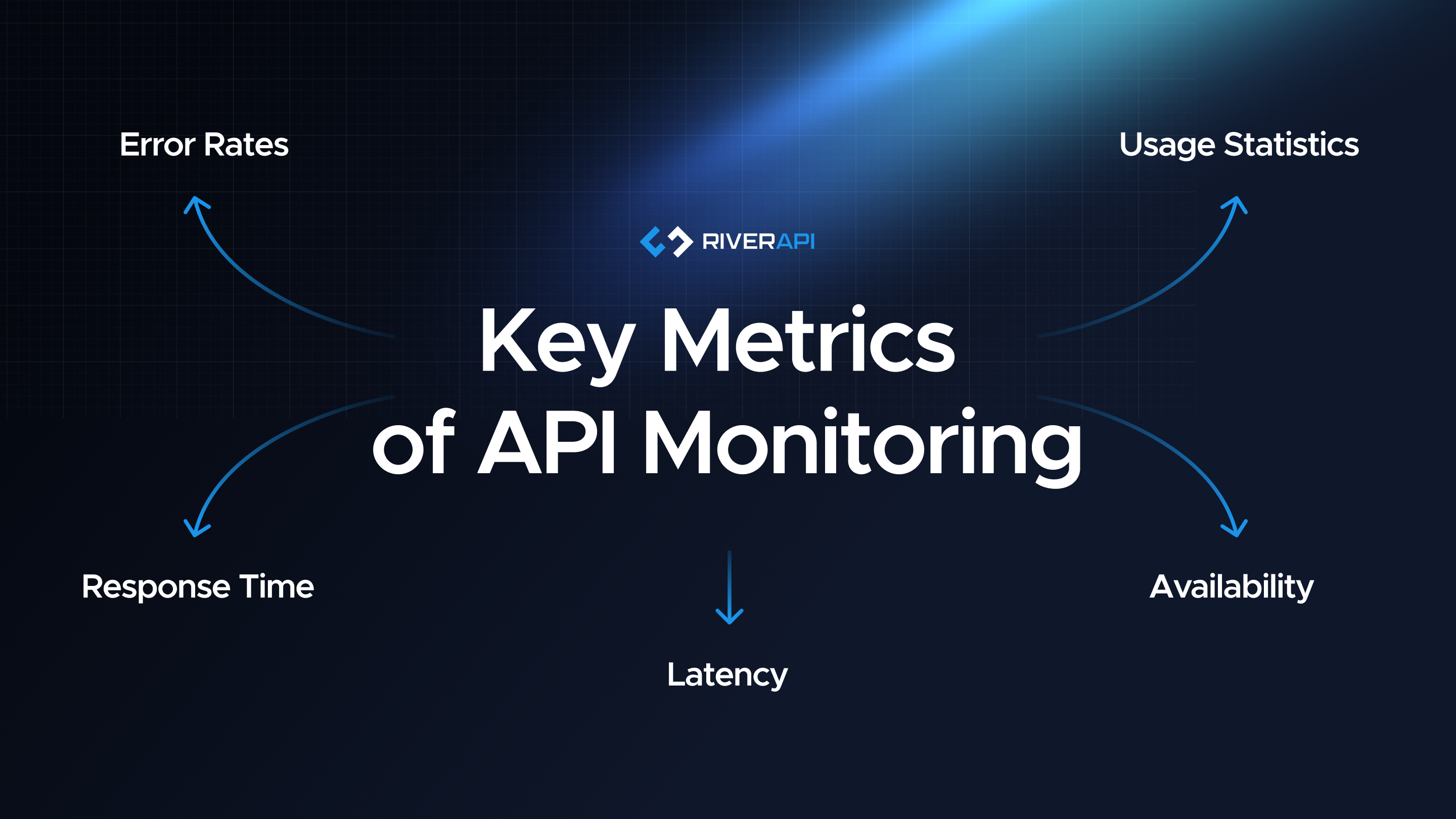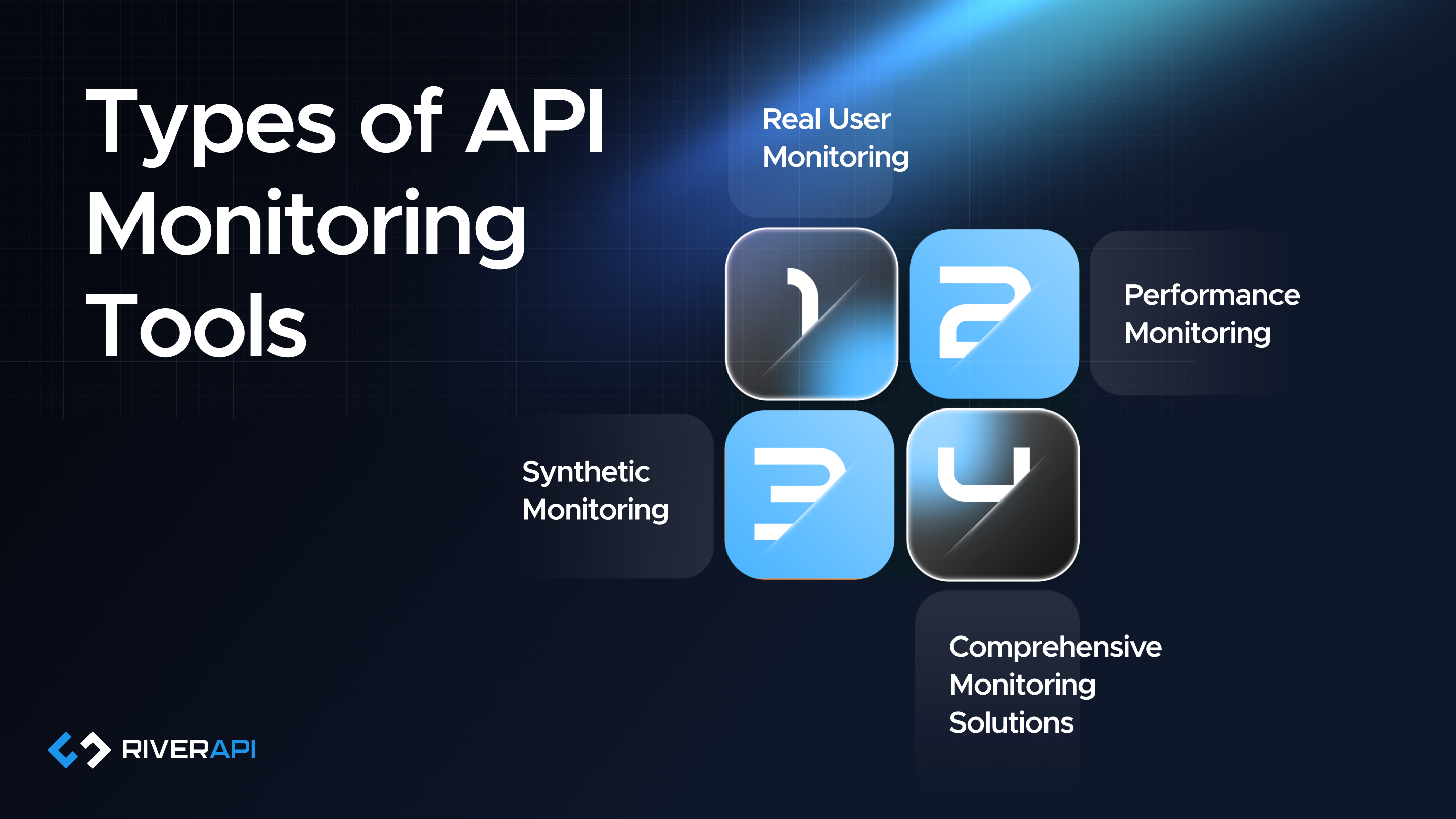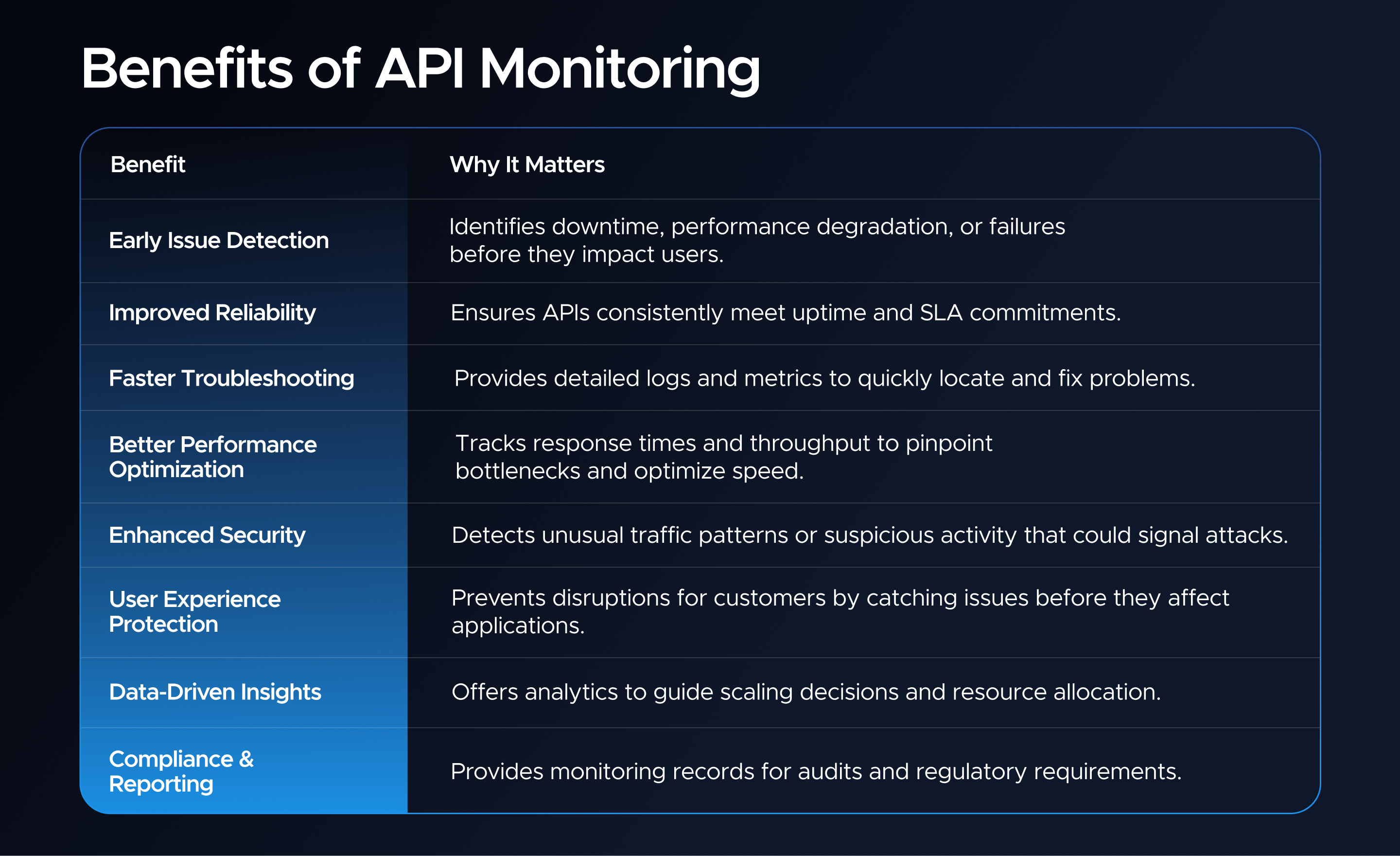Since the beginning of 2025, companies have increasingly used API monitoring tools to automate alerts, collect actionable performance metrics, and optimise workflows. API monitoring ensures that developers, DevOps teams, product managers, and decision makers can quickly identify issues and maintain a high-quality user experience.
A well-implemented monitoring solution provides clear visibility into API performance and enables proactive troubleshooting. Organisations can identify problems before they impact customers, improve uptime, and enhance overall service reliability, making API monitoring an essential practice for any digital-first business.
What Is Monitoring API
API monitoring is the process of tracking API endpoints and API interactions to ensure consistent functionality, uptime, and reliability. It provides visibility into how APIs perform under different conditions and helps identify potential issues before they impact users or upstream services.
How API Monitoring Works
API monitoring relies on specialised monitoring tools that collect key metrics, visualise them in a data panel, and send alerts when performance thresholds are exceeded. Metrics such as response speed, latency, error rate, and the success of API requests are tracked continuously, providing teams with actionable insights.
Common Use Cases
Monitoring APIs can serve several critical purposes:
- Monitor APIs for Latency or Downtime: Detect slow responses or outages early to maintain reliable services.
- Observe Third-Party API Responses: Ensure external integrations deliver consistent and accurate data.
- Track Transactions in Microservices or Web Applications: Maintain stable workflows and troubleshoot errors proactively.
By implementing API monitoring, teams can optimise API performance, enhance user experience, and maintain high-quality service across all endpoints.
Key Metrics of API Monitoring
API monitoring provides organisations with the visibility, insights, and tools needed to ensure APIs remain reliable, performant, and efficient. By actively monitoring API endpoints, teams can detect downtime or issues early, improve uptime, enhance the performance of applications, and maintain an optimal monitoring experience for developers and product managers. Effective monitoring is essential for ensuring smooth operations across service-oriented components, third-party APIs, and internal workflows.

Ensure Uptime and Reliable API Availability
Reliable monitoring is essential for ensuring that critical APIs are available when needed. By using uptime monitoring and tracking the number of requests, organisations can quickly detect downtime or disruptions. API monitoring ensures that workflows, application programming tasks, and upstream services continue to function without interruptions. The primary use case for API monitoring is to maintain consistent API availability and guarantee service reliability for both internal teams and end users.
Reduce Error Rates and Troubleshoot Issues
API monitoring offers real-time alerts and monitoring metrics that help teams identify errors before they affect users. Proactive monitoring enables teams to troubleshoot API calls, requests, and endpoints, reducing error rates and minimising service interruptions. By analysing metrics monitoring, organisations can detect patterns, uncover the root causes of issues, and implement fixes quickly, enhancing reliability and operational efficiency.
Improve User Experience
APIs may experience variable response times or latency, which directly impacts user experience. Monitoring provides actionable performance metrics, enabling teams to optimise API calls, reduce latency, and ensure that applications perform consistently. Observing API requests trends and workflow performance allows organisations to deliver faster and more responsive services for end users, even under high traffic conditions.
Gain Actionable Metrics
Access to detailed monitoring metrics helps teams make data-driven decisions. By tracking response time, error rates, API requests, and the number of requests, developers and product managers can optimise API performance, improve workflows, and enhance application efficiency. Monitoring data also enables teams to benchmark the performance of applications over time and refine strategies for scaling APIs.
Support Compliance and Accountability
Monitoring supports compliance with service level agreements (SLAs) and internal standards. Console, alerts, and consolidated metrics monitoring provide a comprehensive view of API interactions, uptime, and performance. This ensures accountability and transparency, helping teams adhere to organisational monitoring practices and maintain reliable, high-performing APIs.
Types of API Monitoring Tools
Choosing an API monitoring tool that fits your environment is critical. A robust monitoring solution enables teams to track endpoints, collect monitoring data, and ensure that APIs are available and performant. API monitoring offers a variety of approaches depending on the specific use case for API monitoring, including proactive testing, real user tracking, and comprehensive observability.

Synthetic Monitoring
Synthetic monitoring simulates API requests to endpoints and monitors their responses. This proactive form of API testing allows teams to detect downtime, measure latency, and analyse response times under controlled conditions. By simulating transactions, synthetic monitoring ensures that APIs perform reliably before real users are affected, enhancing the monitoring experience and reducing the risk of errors in production.
Real User Monitoring
Real user monitoring captures API interactions as they occur in production, tracking API performance metrics and user behaviour. This approach provides insight into how APIs behave under real-world traffic conditions and reveals bottlenecks that synthetic monitoring may miss. Observing actual API requests enables teams to improve workflow efficiency, optimise API calls, and deliver better user experience.
Performance Monitoring
Performance monitoring continuously tracks key metrics, including response time, latency, throughput, error rates, and API requests. This allows teams to identify degradation trends and optimise API performance. Monitoring metrics collected from performance monitoring tools inform developers how the API is performing under various loads and help predict issues before they impact the number of requests or overall application functionality.
Comprehensive Monitoring Solutions
Comprehensive monitoring solutions integrate dashboards, a notification system, synthetic monitoring, real customer monitoring, and performance monitoring to provide a holistic view of API health. These solutions allow teams to monitor upstream services, service-oriented components, cloud services, and third-party APIs in one unified platform. Consolidated metrics monitoring helps teams ensure reliable processes, optimise workflows, and maintain the performance of applications while keeping the API available and responsive.
Popular Monitoring Tools
Organisations can select an API monitoring tool such as Datadog, AWS CloudWatch, or custom admin panels to monitor APIs effectively. Choosing the right tool is essential for capturing metrics to monitor, analysing monitoring data, setting up alerts, and optimising API performance. By leveraging monitoring and observability features, teams can enhance the efficiency of applications, maintain reliable APIs, and ensure that APIs can scale smoothly with growing demands.
Step-by-Step How to Monitor Your APIs
Monitoring APIs effectively requires a structured approach that combines the right tools, configuration, and ongoing analysis. Following these steps ensures reliable tracking of API performance and early detection of issues.
Select a Monitoring Tool
Choose an API monitoring solution that fits your environment, whether cloud-based, on-premises, or hybrid. Consider factors such as support for synthetic monitoring, real user monitoring, dashboards, and a notification system. Popular examples include Datadog, AWS CloudWatch, and customisable monitoring platforms. Selecting the right tool allows you to monitor APIs efficiently and adapt as your infrastructure grows.
Configure Endpoints and Authentication
Set up the monitoring tool by configuring API endpoints, authentication credentials, and monitoring intervals. Ensure all critical API calls and requests are included, covering both internal service-oriented components and third-party integrations. Proper configuration enables accurate tracking of uptime, latency, and rates.
Define Metrics to Monitor
Identify the key metrics to monitor, including response time, rate, throughput, and overall API availability. Configure the tool to collect and visualise these metrics in the control panel, enabling teams to spot trends and make data-driven decisions.
Enable Alerts
Set up alerts to notify teams immediately when performance thresholds are breached. Alerts ensure rapid response to failures, slow response times, or unexpected errors, helping to minimise downtime and protect user experience.
Test and Validate
Simulate API calls and validate that monitoring configurations and alerting rules function as intended. Continuous testing ensures that your monitoring setup remains reliable and actionable.
Common API Monitoring Challenges and How to Solve Them
Even with advanced monitoring tools, organisations face challenges that can affect the reliability of API monitoring. Understanding these challenges and applying best practices is essential for effective oversight. By following API monitoring best practices, teams can troubleshoot efficiently, maintain uptime, and ensure consistent API performance.
Misconfigured Alerts
Improperly configured alerts can create false positives or miss critical failures. The solution is to carefully define thresholds, focus on the most important metrics, and fine-tune alerting rules.
Latency and Intermittent Failures
APIs may experience high latency or sporadic errors. Monitoring should track response times and error rates continuously, allowing teams to identify patterns and troubleshoot issues proactively.
Overloaded Dashboards
Excessive metrics or poorly organised control panels can cause noise and reduce focus. Prioritise key metrics, group endpoints logically, and create clear visualisations to simplify observability.
Third-Party API Issues
Dependencies on external APIs can introduce performance variability. Establish service level expectations, monitor these endpoints, and integrate troubleshooting workflows to quickly address external failures.
Use Cases for API Monitoring and Examples
API monitoring is critical across multiple scenarios where uptime, performance, and reliability directly impact business operations and user satisfaction. Explore use cases that demonstrate how API monitoring enables organisations to proactively manage endpoints, troubleshoot issues, and maintain high-performing systems.

Lead Generation
Monitor webhooks and form submission APIs to ensure data is captured reliably. Detecting downtime quickly prevents missed leads and preserves workflow integrity.
Transaction Monitoring
Financial and e-commerce APIs require accurate responses for every API call. Monitoring ensures transactions are completed correctly, helping maintain customer trust and operational stability.
Microservices
In complex architectures, monitor interactions between service-oriented components to identify bottlenecks, optimise API requests, and maintain efficient workflows.
Performance Optimisation
Track metrics such as latency, response time, and error rate to enhance API performance. Use collected API metrics to optimise endpoints, improve throughput, and deliver a better user experience.
Best Practices for API Monitoring
Effective API monitoring is essential for ensuring that APIs are reliable, performant, and always available. By following proven monitoring practices, teams can proactively identify issues, optimise API performance, and maintain high-quality user experiences. A robust API monitoring solution enables organisations to monitor key API interactions, ensure uptime, and troubleshoot efficiently, while providing the data to ensure decisions are informed and metrics are actionable.
Use Consistent Naming Conventions
Standardising the naming of all monitored API endpoints allows teams to quickly locate a key API and interpret metrics to watch effectively. Consistent endpoint naming helps control panels remain organised, improves the monitoring experience, and allows you to observe trends across multiple services, especially when it comes to detecting anomalies or repeated errors.
Configure Alerts for Critical APIs
Alerts are essential to notify teams when a critical API is unavailable, returning incorrect data, or experiencing high latency. A properly configured notification system helps you quickly respond to failures and ensure the API is available to dependent workflows. This proactive monitoring enables teams to return a response promptly and maintain the health of applications.
Review Metrics Regularly
Regularly analysing performance metrics, API usage, and response times allows teams to detect trends, identify degradation, and optimise the application’s performance. Monitoring data and metrics to watch help teams maintain reliable monitoring, refine API calls, and improve the performance of applications before issues escalate.
Maintain Observability
Dashboards, logging, and continuous metrics collection enable comprehensive monitoring and observability. Observability allows teams to trace transactions, understand dependencies, and correlate API interactions across service-oriented components and cloud infrastructure. This approach ensures that changes in one service do not unexpectedly impact another and allows you to observe the API’s performance in real time.
Integrate Monitoring with DevOps Workflow
Integrating API monitoring into the DevOps workflow connects alerts, admin panels, and troubleshooting processes. This alignment enables rapid issue resolution, optimises API calls, and ensures seamless application performance. Teams can leverage monitoring data to ensure the application’s performance meets user expectations and business goals while helping you quickly resolve bottlenecks.
Advanced Monitoring Strategies
To maintain a comprehensive API monitoring strategy, organisations should combine multiple monitoring approaches to gain deeper insights and optimise API efficiency.
Combine Synthetic and Real User Monitoring
Synthetic monitoring simulates API requests to proactively test endpoints, while user monitoring tracks actual API interactions. Using both approaches enables teams to observe API performance comprehensively, especially when it comes to understanding real-world latency, throughput, and user experience. This strategy ensures APIs are always available and return the correct data.
Monitor Dependent Services
APIs often rely on third-party services or internal microservices. Monitoring these dependent services allows teams to detect hidden bottlenecks and prevent unexpected failures. Choosing a tool that supports end-to-end monitoring data to ensure smooth operation across all services and enables you to monitor the API ecosystem effectively.
Track API Interactions Across Services
Observing API transactions across microservices, cloud infrastructure, and application programming environments provides insight into workflow efficiency. This strategy helps optimise API calls, reduce response times, and maintain the health of applications. It also allows teams to understand how different components interact, which is critical for maintaining uptime and application reliability.
Use Metrics to Optimise API Calls
Performance metrics such as latency, throughput, error rate, and the number of requests are essential to refine API calls and enhance the application’s efficiency. Leveraging these metrics helps teams improve the API’s performance, ensures the API may be available when needed, and allows you to observe trends to prevent issues proactively. This comprehensive approach guarantees that the API ecosystem performs reliably and delivers consistent results to end users.
Future of API Monitoring in 2025 and Beyond
API monitoring is evolving rapidly, with new technologies and methodologies shaping the future of observability, performance, and security. By 2025, organisations will rely on smarter, more comprehensive API monitoring solutions to enhance efficiency, maintain uptime, and deliver secure, reliable services across complex cloud and microservices environments.
AI-Driven Monitoring Solutions
Artificial intelligence is increasingly being used to detect anomalies, predict failures, and generate predictive alerts. AI-driven monitoring reduces manual oversight while improving accuracy and response times.
Predictive Alerts and Anomaly Detection
Monitoring tools are moving beyond static thresholds. Predictive alerts anticipate potential issues, allowing teams to act before errors affect users, while anomaly detection identifies unusual API behaviours that could indicate underlying problems.
Smarter Dashboards and Observability
Future dashboards will integrate multiple metrics, providing a unified view of API performance, transactions, and user experience. Enhanced observability enables teams to correlate events and debug effectively across cloud infrastructure and service-oriented components.
Increased Focus on API Security
Alongside performance monitoring, API security is gaining attention. Ensuring secure authentication, protecting sensitive data, and monitoring for suspicious activity are becoming integral parts of API monitoring practices.
Secure, High-Performing APIs with RiverAPI
API monitoring provides organisations with critical insights to maintain uptime, optimise the performance of APIs, and enhance user experience. By tracking key metrics, analysing response times, and leveraging dashboards, teams can proactively debug issues and ensure reliable service. RiverAPI specialises in effective API monitoring solutions, offering customisable dashboards, alerting capabilities, and performance optimisation strategies tailored to your workflows.
Start monitoring your APIs today with RiverAPI and ensure reliable, high-performing APIs for your organisation. Whether you manage microservices, third-party APIs, or cloud services, RiverAPI helps you monitor your APIs efficiently and gain actionable insights to enhance overall system performance.
Frequently Asked Questions about API Monitoring
What is the goal of API monitoring?
The goal of API monitoring is to track API performance, availability, and functionality to prevent downtime, reduce error rates, and ensure a consistent user experience.
Why is API monitoring essential for microservices?
service-oriented components rely on numerous interconnected APIs. Monitoring ensures that each service communicates effectively, identifies bottlenecks, and maintains reliable performance across the system.
How can alerts help improve API performance?
Alerts notify teams immediately when response times degrade, errors occur, or endpoints fail. Timely notifications allow rapid troubleshooting and prevent disruptions from affecting users.
What tools does RiverAPI recommend for comprehensive API monitoring?
RiverAPI recommends monitoring solutions that combine dashboards, synthetic and real user monitoring, observability features, and alerting capabilities. These tools enable efficient tracking of API endpoints, transactions, and performance metrics.


